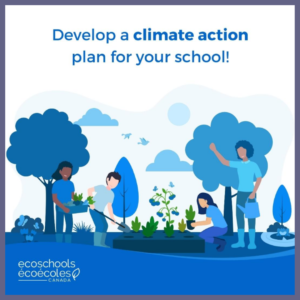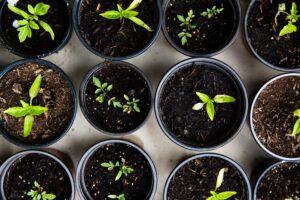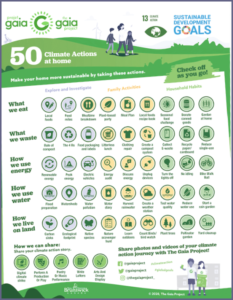Top 8 Easy Ways to Bring Climate Action into Your Classroom
Nov 2, 2022
Climate change – it’s daunting, it’s frustrating, it feels unsolvable. But innovation begins with a pursuit for knowledge and a culture of experimentation – and the classroom is where innovators emerge.
The next generation of leaders is still in the classroom, and teachers have the opportunity to spark excitement towards tackling issues around climate change. But what does climate change education look like, and how can teachers integrate environmental awareness into their curriculum? The answers are simpler than you’d expect. Of course, teachers who want to dive deep into the science of climate change will need to take a more methodological approach, but for teachers who simply want to lay a framework of environmental consciousness within their classroom, empowering students to take climate action is feasible.
1. Sign up for EcoSchools Canada
Whether or not you decide to pursue EcoSchools Platinum certification, EcoSchools Canada is an excellent source of climate action and sustainability lessons and activities for all grade levels, and in both French and English. EcoSchools is free, and teachers can sign up anytime throughout the school year. With a slew of environmental actions and project ideas that range from simple exercises to in-depth projects, signing up to EcoSchools Canada is a no-brainer!

2. Take Your Students Outside
Spending even a small amount of time outdoors each day can help support mental health, and fosters an appreciation for nature. As I sit here in my backyard on a cool autumn day, I can contest that even just being still, listening to the sounds and smelling the smells of a forest can bring peace and inspiration. This type of relationship with nature helps put into perspective the importance of reciprocity with the environment, and builds a personal connection with nature. A “sit spot” is an excellent way to ignite a personal appreciation for nature within your students. Take your students outdoors and ask them to find a quite spot, away from their classmates, to sit and pay close attention to what’s going on around them. What do they hear? What do they smell? What does the grass feel like? How does this exercise make them feel? If you want to elevate this activity, ask them to write a stream of consciousness to help students tap into their thoughts as they arise. Alternatively, if you would like to take a more active approach to spending time outdoors, ask your students to complete an outdoor scavenger hunt or schoolyard cleanup!
3. Create Collaborative Mural with your Students
One way to bridge the gap between climate action and the arts is to facilitate a collaborative mural with your class. Some students struggle with science and math, despite having an interest in nature. For students that find it difficult to communicate mathematically, (or even students that struggle to communicate verbally), using art as a medium for communication can be inclusive and engaging. While creating artwork independently has a lot of merit, creating a collaborative mural can help build personal connections and community within a class (both critical in tackling climate change).

So how does a collaborative mural work in climate change education? Start by instigating a lesson or group discussion. Take an approach that works best for you and your students. This can be a lesson in climate science, or a lesson in environmental humanities, but either way, students should have the opportunity to contribute to the conversation. Afterwards, invite your students to share their learnings on a large canvas or paper banner”. This is an opportunity for students to express what they find interesting or important. Once complete, the banner can be displayed in your school or classroom for the remainder of the year, reminding students of the unique perspectives that exist within their classroom community.
4. Start an Indoor Gardening Project
An outdoor school garden or food forest is an amazing way to transform your school yard and inspire students to take climate action, but these tend to be larger projects that require budgets and time commitments. Planting indoors, however, can be as simple as you want to make it. Having students plant seeds is an excellent, hands-on way to facilitate conversations about science, food security, or pollinators. Students will watch and care for their sprouts, which helps to build direct connections to course content.

5. Start a GOOS Paper Bin
A bin of paper that is “Good On One Side” is an excellent, simple and useful way to engage directly with sustainability within your class. Students may take or leave paper that has been used on one side but blank on the other, encouraging students to reduce their paper waste and reuse paper that is no longer needed. And if you’ve signed up to EcoSchools this action will earn you points!
6. Promote Waste-Free Lunches
Waste free lunches can be a fun and engaging way to show students that they have the power to take climate action in their daily lives. But to really inspire your students to participate, it’s important to discuss the effects of waste on the environment, as well as how to properly recycle and compost. An easy way to teach elementary-aged children is to register for the Trash Tracker Program. A member of The Gaia Project team will visit your class and facilitate a hands-on session about waste – a perfect (and easy) start to launching a waste-free lunch program in your class!
7. Bring Environmental Literacy into Your Classroom
Books are an amazing resource. They can be fun, educational and can spark meaningful thought and discussion. Environmental literature exists for all grade-levels and can be easily integrated into course curriculum, making it a perfect way to broaden your students’ perspectives on scientific and social environmental topics. Select a book for your students to read or challenge them to find an environmental book that aligns with their personal interests. Not sure where to start? Check out these top picks of environmental books recommended by The Gaia Project team!
8. Request a 50 Climate Actions Scratch Poster from The Gaia Project
Available for Kindergarten to grade 12, the 50 Climate Actions Scratch Poster is a free resource offered to schools across New Brunswick. Challenge your students to complete climate actions such as packing litterless lunches, unplugging devices, and starting a classroom compost. Students will scratch each action off the poster after they are achieved. How many climate actions can your students take this year?

Taking climate action doesn’t have to be complicated, and even small actions are worth celebrating. When young people learn that they are capable of making a positive impact within their communities they are empowered to do just that. When their efforts are recognized, they become inspired. And when they are taught that solutions to climate change are within their reach, they believe it.
Reference List:
- “Home.” EcoSchools Canada, 26 Sept. 2022, https://ecoschools.ca/.
Author: Katelyn Plant, Marketing & Communications Manager
Follow us on social for more stories, news and updates:
Facebook: www.facebook.com/gaiaproject
Instagram: @thegaiaproject_
Twitter: @gaiaproject
LinkedIn: @thegaiaproject-projetgaia
TikTok: @thegaiaproject_